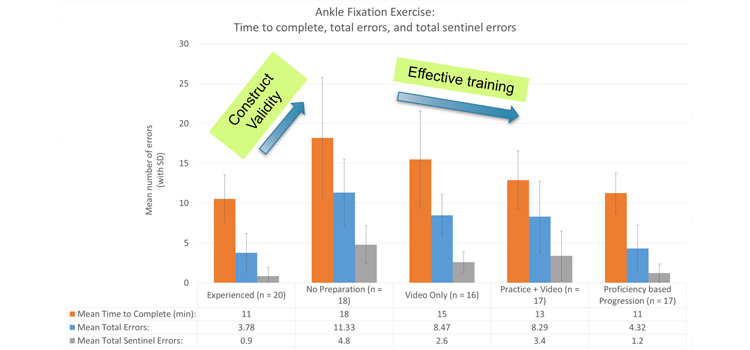Pro-C: AO Trauma’s Proficiency Curriculum
Three years after its launch, the first large-scale randomized trial of teaching methods within the AO Foundation is complete. With support from the Strategy Fund, the Pro-C: AO Trauma’s Proficiency Curriculum project yielded reliable metrics to assess trainees’ performance of practical tasks in fracture care, positioning the foundation to extend its role as the global leader in medical education.
Taking an evidence-based approach to teaching surgical skills, the Pro-C project demonstrated that measuring and using a specific strategy, Proficiency-based Progression (PbP), provides feedback to trainees on correctable points and also results in trainees having a significantly greater chance of successfully applying what they learn.
The project was led by AO Trauma faculty members and co-investigators Prof Pierre Guy (University of British Columbia Department of Orthopedics, Vancouver, CA), Prof Michael Baumgaertner (Yale School of Medicine, New Haven, CT, US), Dr Matthew L. Graves (University of Mississippi Medical Center, Jackson, MS, US), Kevin Inkpen, MSc (biomedical engineer, University of British Columbia), and Prof Anthony Gallagher, PhD (University College Cork, IE). The project used Gallagher’s PbP approach to develop validated metrics and to compare PbP to other teaching methods during an AO Trauma basic principles course.
“This project is a huge step forward in developing metrics around how surgical skills and tasks are taught,” Guy said. “The AO leads the world by training its faculty to teach effectively. Its teaching model is emulated by many organizations. This project positions the AO to once again lead the world and innovate in the way we teach technical skills for fracture care.”
The project got underway with the aim of gaining experience with the PbP approach to teaching fracture care. Validated assessment metrics were developed for teaching the AO Skills Lab and a simple ankle fracture fixation exercise, and the team measured the impact of various teaching strategies applied to novice residents who had never attended an AO basic principles course (Fig. 1). Additionally, a guide was produced for the development of future proficiency-based modules to be used by other AO clinical divisions-a step that underlines the project’s transversal nature.
Guy said the project’s findings offer the AO the opportunity to extend its leadership in orthopedic education and become the standard reference for skills teaching—in the same way that the AO has become the gold standard for didactic and small group teaching, and for the systematic development of its high-quality faculty through training.
“This approach would represent a change in the way we’ve taught technical skills, but it’s also an opportunity for the AO to lead in medical education with an evidence-based approach supported by a randomized trial,” he said. “Increasingly, around the world, there is a demand by licensing authorities for information about surgeons’ ability to carry out technical tasks. The development of methods to both teach and assess individual skills answers that need.”
Guy said such an ambitious undertaking would not have been possible without Strategy Fund support.
“The entrepreneurial nature of the Strategy Fund allowed this project to happen,” he explained. “There was a certain risk involved, and the Strategy Fund was willing to take this risk to test a different way of teaching our trainees.”
As the project concludes, the project team will communicate its methodology, findings and learnings within the AO as well as outside of the AO, including publication in peer-reviewed journals.




